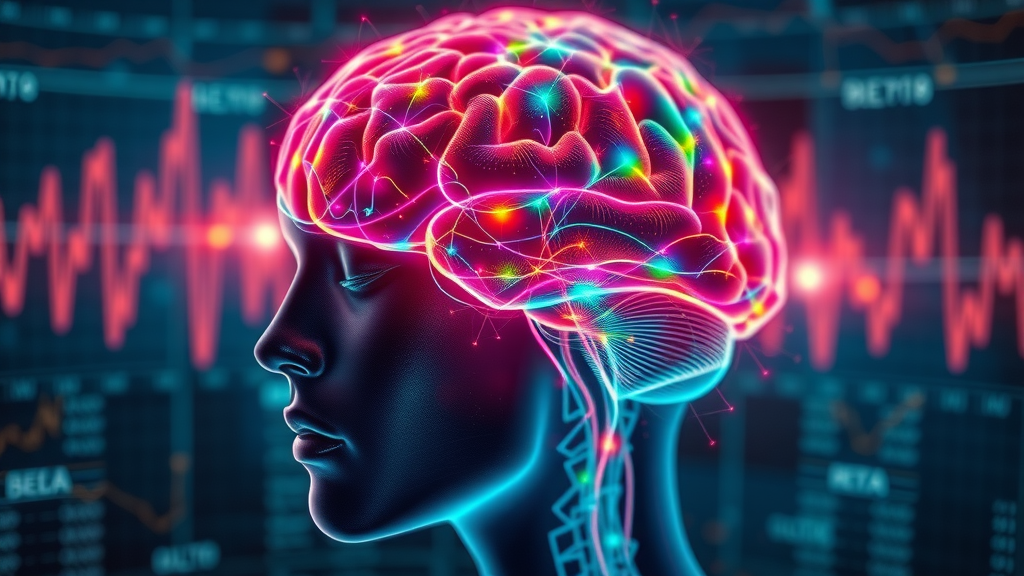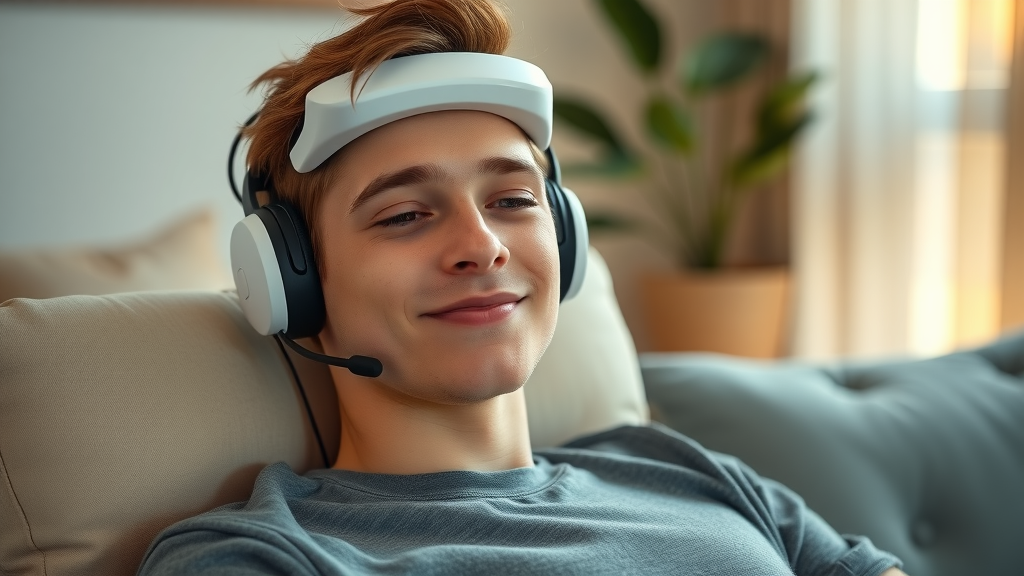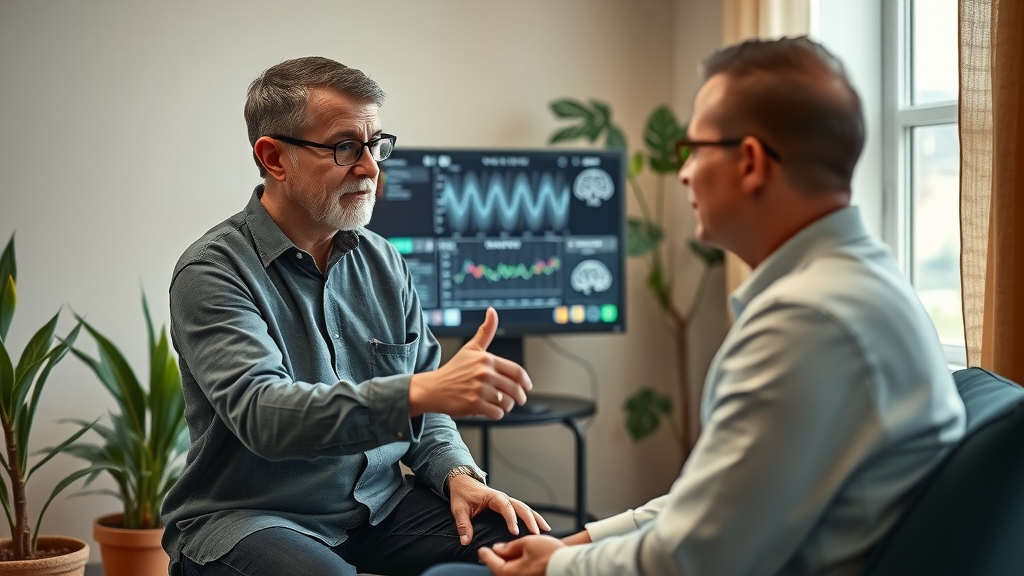Did you know that over 31% of adults experience anxiety disorders —yet fewer than half receive proper mental health care? Advances like brainwave biofeedback are disrupting this status quo, giving individuals a science-backed way to transform how they feel, focus, and heal. In this comprehensive guide, you’ll discover why so many are turning to this technology, how it works, and practical steps to start using it in your own life. Ready to see just how much this brain science breakthrough can impact your journey to mental wellness?
Unlocking the Power of Brainwave Biofeedback: A Surprising Fact That Could Change Your Understanding
If you’ve ever felt that your mind is out of sync with your emotions or that stress just won’t let go, here’s the eye-opener: brainwave biofeedback allows you to see your brain’s electrical activity in real time and learn how to manage it intentionally. This approach isn’t just new age hype—it’s grounded in neuroscience and backed by increasing research on its effectiveness for mental health . Unlike traditional therapy, which addresses symptoms after the fact, biofeedback offers direct feedback on your brain waves as you engage in exercises designed to enhance focus, reduce anxiety, and improve mood. The science and technology now make it possible for anyone to access “live data” from their own mind, leading to measurable mental shifts.
Imagine being able to track whether your alpha wave activity matches a relaxed state, or if those beta waves are signaling overdrive stress—then actively steering your mental state towards calm or focus. This feedback training empowers you to regulate your brain wave patterns, making once-mysterious inner experiences actionable. Whether you struggle with stress and anxiety, want to boost concentration, or are searching for options beyond medication, brainwave biofeedback offers a surprising, science-driven path forward.

Why Brainwave Biofeedback Is Gaining Momentum in Mental Health
The interest in brainwave biofeedback is surging for good reason. Modern mental health challenges require innovative solutions, and traditional treatment alone often isn’t enough for conditions like anxiety, depression, and hyperactivity disorders. What sets brainwave biofeedback apart is its unique ability to harness real-time data from the brain, targeting underlying electrical activity that influences mood, thought patterns, and behavior. With this approach, individuals receive immediate feedback, enabling them to learn strategies for healthier mental function—much like biofeedback for the body, but on a cognitive level.
Clinics, therapists, and even home device makers are recognizing the value of giving people actionable control over their brain waves . This empowerment is vital as rates of anxiety, stress, and ADHD continue to rise on a global scale. Furthermore, advances in EEG biofeedback and neurofeedback training have made brainwave monitoring more accessible, affordable, and evidence-based than ever before. It’s no wonder people are exploring brainwave biofeedback as an alternative or complement to medication and traditional talk therapy.
How Brainwave Biofeedback Works: The Science Behind Mental Health Transformation
At its core, brainwave biofeedback (sometimes called neurofeedback therapy) leverages advanced technology—typically electroencephalogram (EEG) sensors—to monitor the electrical activity of your brain. Via carefully designed sessions, you get immediate, visual, or auditory feedback as you perform mental exercises, relaxation techniques, or cognitive tasks. The goal? Redirect your brain wave patterns to healthier states by reinforcing positive changes in brain function through feedback training. This form of feedback bridges the gap between awareness and action, transforming how your mind responds to internal and external stressors.
The science is rooted in the fact that different mental states—relaxation, concentration, anxiety, creativity—correspond with distinct brain waves (such as alpha waves, beta waves, theta waves, and so on). When your brain’s electrical activity is unbalanced (for example, excessive fast beta wave activity in anxiety, or not enough alpha waves in relaxation), your mental health can suffer. Biofeedback devices help train your brain to increase or decrease specific types of waves, using a method akin to operant conditioning (rewarding your brain with feedback when you reach desired states). This can offer noticeable improvements in stress reduction, focus, and emotional regulation.
The Role of Brain Waves in Mental Health and Emotional Regulation
Your brain is an orchestra of electrical signals, generating a symphony of brain wave patterns that directly influence how you feel and think. Each major type of wave—Delta, Theta, Alpha, Beta, Gamma—corresponds with specific states of consciousness and mental health effects. For instance, alpha wave activity is linked to creative flow and calm, while beta waves are associated with alertness and problem-solving but can also spike under stress or anxiety. Mastering your own brain wave activity can mean taking charge of emotional ups and downs, sleep cycles, and even how clearly you focus during everyday tasks.
Researchers have identified that imbalances in slow cortical potential (like excess delta or theta activity) can contribute to conditions such as ADHD, PTSD, and insomnia. On the other hand, regulated theta waves can promote deep relaxation or creative thinking, while optimized alpha waves are key to combating rumination and chronic stress. Brainwave biofeedback targets these wave patterns by helping you literally reshape your mental landscape with consistent practice and feedback, making emotional regulation a learnable skill.
-
Key Types of Brain Waves Targeted by Brainwave Biofeedback:
- Delta
- Theta
- Alpha
- Beta
- Gamma

EEG Biofeedback and Its Relationship to Neurofeedback Training
EEG biofeedback , a cornerstone of neurofeedback training , involves tracking your brain’s electrical activity via non-invasive sensors placed on the scalp. The resulting data—your brain’s real-time “scoreboard”—is then presented through computer screens, games, or sounds, helping you understand and regulate your brain wave activity. Neurofeedback treatment builds on this by using sophisticated algorithms and protocols to target specific symptoms, such as inattention, anxiety, or insomnia, based on observed brain wave patterns.
Over time, EEG biofeedback supports sustained changes in brain activity by reinforcing desirable wave patterns. The feedback process is critical; it’s what enables the brain to learn, much like physical exercise helps retrain muscles. Leading clinics use evidence-based neurofeedback protocols for conditions ranging from hyperactivity disorder to trauma recovery, personalizing sessions to individual needs. This comprehensive approach is why more mental health professionals and patients are integrating feedback training into mainstream care and long-term wellness routines.
"Neurofeedback therapy represents a powerful new frontier in mental health—it empowers patients to see their own brain in action, and to shape healthier patterns in ways that medication cannot." — Leading Neuroscientist
Essential Benefits of Brainwave Biofeedback for Mental Health
Dozens of peer-reviewed studies now show that brainwave biofeedback can offer significant benefits for mental health, especially when other treatments haven't yielded the desired results. By providing immediate, personalized feedback, biofeedback enables you to build self-regulation skills—not just rely on external fixes. Whether you're seeking targeted support for stress, anxiety, ADHD, or just want to boost your cognitive performance, brainwave feedback can make your mental wellness journey more effective, measurable, and empowering.
The true value of this approach is its versatility and customizability. Each user’s protocol can focus on unique patterns, such as reducing intrusive nightmares for PTSD, enhancing focus during school or work for ADHD, or optimizing relaxation for those battling insomnia. This makes feedback training a precise, flexible, and practical option for a wide array of mental health concerns—often with fewer side effects than medications or invasive interventions.

How Neurofeedback Treatment Supports Anxiety, Stress, and ADHD
One of the remarkable strengths of neurofeedback treatment is its effectiveness in addressing anxiety, chronic stress, and hyperactivity disorder (ADHD). During a typical session, clients learn to modulate their brain waves , such as reducing excessive beta wave activity which often underlies anxious thinking or hypervigilance. This training process, via real-time feedback, can result in improved calm, focus, and emotional equilibrium.
For ADHD, biofeedback protocols frequently target enhancing beta and alpha wave activity in areas responsible for attention and impulse control. Many individuals—including children with hyperactivity disorder—report measurable improvements in classroom focus, emotional outbursts, and overall functioning. Beyond symptom relief, neurofeedback cultivates skills for long-term self-regulation, arming clients with tools to face life’s stressors more confidently and with greater resilience.
Improving Focus and Cognitive Performance With Brainwave Biofeedback
Cognitive optimization is another frontier for brainwave biofeedback . The immediate feedback on brain wave patterns empowers sharp mental performance—sought after by students, professionals, and athletes alike. By increasing alpha waves , users often report brighter focus, less mental fog, and an enhanced capacity to learn or remember information under pressure. Likewise, fine-tuning theta and beta wave ratios can drive creativity while reducing tuning out or distractions, which commonly hinder productivity and academic achievement.
Elite athletes and performers have used these principles to sharpen concentration and deal with the psychological effects of high-stakes environments. With regular feedback training sessions—whether in clinics, at home, or via wearable technology—everyone from musicians to executives can train the mind for flexibility, adaptability, and resilience. Brainwave biofeedback is proving to be less about “fixing” illness and more about unlocking human potential.
-
Top Benefits of Brainwave Biofeedback:
- Reduced Anxiety and Stress
- Enhanced Cognitive Function
- Benefits for Hyperactivity Disorder
- Potential Relief for Insomnia and PTSD
Comparison Table: Brainwave Biofeedback vs. Other Feedback Training Modalities
| Modality | Primary Target | Method | Main Benefits | Level of Research Support |
|---|---|---|---|---|
| Brainwave Biofeedback | Brain electrical activity (EEG) | Real-time EEG feedback | Stress/anxiety reduction, focus, mood, sleep improvement | Strong (growing clinical evidence) |
| Biofeedback | Heart rate, muscle tension, skin conductance | Sensory feedback with monitors | Relaxation, pain management, migraine relief | Strong (established in clinical use) |
| EEG Biofeedback | Electrical activity (EEG) | EEG sensors, visual/audio feedback | ADHD, anxiety, insomnia | Moderate to strong |
| Neurofeedback Training | Specific brain wave patterns | Computer-based feedback & targeted training | ADHD, PTSD, emotional regulation | Strong (ongoing research) |
| Quantum Biofeedback | Bioenergetic field/frequencies | Frequency-based feedback devices | Holistic wellness (evidence still preliminary) | Weak to moderate (emerging field) |

Neurofeedback Training: The Core Process of Brainwave Biofeedback
The centerpiece of brainwave biofeedback is neurofeedback training , a process designed to put science in the hands of individuals. Neurofeedback therapy takes place in structured sessions, with each step carefully tailored to your unique brain wave profile and clinical goals. As you undergo real-time feedback on your electrical activity, you receive prizes or cues for reaching optimum brain states. Over time, repeated sessions strengthen these neural patterns, paving the way for lasting improvement in cognition and mental health .
This type of feedback training isn’t just for those struggling with mental health conditions —it’s equally valuable for anyone seeking mental clarity, emotional balance, or cognitive edge. Because the process involves tracking slow cortical potential and other critical markers, your therapy is both data-driven and dynamic. This ensures interventions are targeted, measurable, and safe for a broad range of ages and conditions.
Step-by-Step: What Happens During a Typical Neurofeedback Therapy Session
Neurofeedback sessions are structured yet comfortable, designed to safely guide you through brain wave modulation. The process begins with an introduction to the equipment: EEG sensors are placed gently on your scalp to read electrical activity—no pain, no invasion. You’ll likely sit in a relaxed position, often watching feedback on a screen or listening to cues in headphones. This is followed by real-time monitoring, where software tracks your brainwaves as you perform simple tasks or relaxation exercises.
The most important part is feedback and reward. When your brain produces the target wave patterns, you receive an immediate cue (like a visual animation or sound), reinforcing the desired state. This operant conditioning helps your brain repeat healthy responses. Finally, your session ends with progress tracking—a summary of how your brain activity shifted, which informs future protocols. Sessions are typically repeated weekly to encourage meaningful, long-term change.
-
Stages of a Session:
- Introduction to Equipment
- Real-Time Brainwave Monitoring
- Feedback and Reward Mechanisms
- Progress Tracking

EEG Biofeedback vs. Neurofeedback Training: Key Differences Explained
Although the terms EEG biofeedback and neurofeedback training are often used interchangeably, there are subtle but important distinctions. EEG biofeedback refers specifically to the use of EEG signals to provide feedback on brain activity—it’s the raw process of measuring and displaying brain waves, often used for general relaxation or alertness training. Neurofeedback, on the other hand, involves a more systemic approach: it combines EEG readings with customized training protocols, software-driven guidance, and specific outcome goals tailored to mental health issues or peak performance ambitions.
While both approaches share core technology, neurofeedback therapy is characterized by its greater focus on clinical goals, measured improvement, and ongoing adaptation based on progress. That’s why neurofeedback is often recommended for ADHD, PTSD, or emotional regulation, while basic EEG biofeedback may be used for wellness, meditation, or simple stress-relief practices. Understanding this key difference helps users choose the most appropriate intervention for their needs and desired outcomes.
Who Can Benefit From Brainwave Biofeedback?
Brainwave biofeedback isn’t just for those with clinical diagnoses—it’s a transformative tool for anyone seeking better mental health, sharper focus, and greater emotional stability. Patients with anxiety and depression have found new hope through neurofeedback treatment, while children and adults with hyperactivity disorder (ADHD) are discovering significant improvements in attention and behavior. The technology is also popular among elite athletes, performance artists, and high-stress professionals aiming to optimize mental edge and maintain calm under pressure.
Thanks to its customizable, non-invasive nature, feedback training can benefit young children, working adults, and seniors alike. Even those without a diagnosed condition use brainwave biofeedback to address sleep issues, chronic stress, or cognitive decline. With proper guidance from certified therapists, nearly anyone can leverage neurofeedback therapy to support well-being, resilience, and personal growth.
-
Ideal Candidates:
- Individuals Seeking Improved Mental Health
- Patients With Anxiety or Depression
- Children with Hyperactivity Disorder (ADHD)
- Athletes and Performers

Real-Life Case Studies: Transformations Using Neurofeedback Treatment
Consider the story of a young professional battling chronic anxiety who, after months of neurofeedback treatment, not only gained calm and resilience, but learned to focus under high-pressure work conditions. Or a child with hyperactivity disorder who saw dramatic drops in classroom outbursts and an improved academic track record after regular feedback training. Athletes, too, have reported using neurofeedback to improve performance, stay composed under competition, and recover faster after setbacks. These real cases underscore biofeedback’s power to transform lives—moving beyond symptom management to true empowerment and self-regulation.
Such stories are increasingly common as more people try brainwave biofeedback and neurofeedback therapy. With guidance from mental health professionals, individuals learn to meaningfully reshape how their brains respond to stress, distractions, and emotional turmoil. The result is often not just reduced symptoms but a profound increase in confidence and quality of life, with benefits that extend well beyond the treatment room.
"Before neurofeedback, I thought anxiety would rule my life forever. After a few months of consistent feedback sessions, I can finally handle stress, sleep soundly, and feel focused—for the first time in years.” — Satisfied Patient
Risks, Limitations, and the Downside of Neurofeedback
While brainwave biofeedback is generally safe and promising, there are risks and limitations to consider. The field is still evolving, and not every clinic or provider adheres to the same standards. Limited regulation means some practitioners may lack adequate training, which can lead to less-than-optimal results or even discomfort during sessions. Side effects, though rare, may include headaches, temporary fatigue, or mild frustration if protocols aren’t tailored correctly.
Ensuring you work with reputable, certified professionals is crucial. Individuals with serious mental health conditions or a history of brain injury should consult a physician before starting neurofeedback training. As with any therapeutic intervention, results can vary. A strong partnership with a trained provider is the best way to ensure safety and maximize mental health outcomes.
Understanding the Downsides: Efficacy, Regulation, and Side Effects
One major limitation is variability in response—some users experience dramatic, rapid change, while others progress more slowly. Efficacy remains an active area of research, with some critics calling for larger studies before declaring neurofeedback a universal solution. The largely unregulated landscape in certain countries means vigilance is needed when selecting a clinic or device. While serious side effects are rare, possible issues range from brief headaches to feeling overstimulated, particularly if sessions are too long or poorly supervised. The best practice is ongoing communication with your therapist and tracking of all responses.
-
Potential Drawbacks:
- Limited Regulation
- Need for Trained Professionals
- Possible Side Effects

How to Start With Brainwave Biofeedback: A Practical Guide
Getting started with brainwave biofeedback is both accessible and practical. First, seek out a licensed or board-certified neurofeedback therapy clinic, where qualified clinicians will perform a comprehensive assessment. This ensures that your feedback training protocol is customized to your unique goals and symptoms, not just a generic template. During your initial visit, your provider will explain the process, answer questions, and ensure comfort with the technology.
After the assessment, you’ll move into a custom program of regular sessions. Each week or so, you’ll receive feedback and updated progress reports, refining your protocol as you go. Communication is key—don’t hesitate to share observations or concerns, and always ask for clarification if something doesn’t feel right. Remember, consistency and professional support are the recipe for lasting results in mental health improvement through biofeedback.
Selecting a Qualified Feedback Training Provider
Choosing the right provider is crucial for your success with brainwave biofeedback. Look for medical or psychological professionals with specialized certification in neurofeedback, preferably affiliated with recognized organizations. Ask about their clinical experience, how they customize protocols, and what kind of outcomes their clients typically see. Beware of clinics promising instant fixes, as sustainable brain change requires commitment and expertise.
-
Steps to Getting Started:
- Initial Assessment
- Customizing the Feedback Protocol
- Monitoring Progress
"Always select a neurofeedback therapy clinic that is transparent about practitioner qualifications, uses evidence-based protocols, and tracks your progress over time.” — Neurofeedback Clinic Expert
Frequently Asked Questions About Brainwave Biofeedback and Neurofeedback
What is biofeedback for brain waves?
Biofeedback for brain waves, called brainwave biofeedback or neurofeedback, is a technique that uses sensors to monitor and display your brain’s electrical activity (brain waves) in real-time. Through feedback on a screen or via sound, you learn to recognize and modify specific brain wave patterns to improve mental health, focus, and emotional control.
What is the downside of neurofeedback?
While most people tolerate neurofeedback well, potential downsides include limited regulation in the field, need for professional expertise, and rare side effects like brief headaches or fatigue. Some people experience slower progress, and effectiveness varies by individual, so it’s not a guaranteed solution for all health conditions.
Does neurofeedback actually work?
Multiple studies suggest neurofeedback can be effective for issues like anxiety, ADHD, sleep disorders, and stress when administered by trained professionals. However, results depend on the individual, their condition, and consistent participation—making provider experience and protocol customization key for optimal results.
What does quantum biofeedback do?
Quantum biofeedback claims to measure and interact with your body’s bioenergetic fields using specialized devices. While it aims to promote overall wellness and energetic balance, the science is still emerging, and it lacks the rigorous evidence supporting EEG-based brainwave biofeedback at this time.
The Bottom Line: Transforming Your Mental Health Journey With Brainwave Biofeedback
Start your brainwave biofeedback journey with a certified professional, set clear goals, and commit to regular sessions—empowering yourself with real tools for lasting mental health and wellbeing.

Brainwave biofeedback, also known as neurofeedback, is a non-invasive technique that enables individuals to monitor and regulate their brain’s electrical activity in real time. By providing immediate feedback on brainwave patterns, this method empowers users to enhance mental health, improve focus, and manage stress effectively.
For those interested in exploring brainwave biofeedback further, the article “Advancing Personalized Digital Therapeutics: Integrating Music Therapy, Brainwave Entrainment Methods, and AI-Driven Biofeedback” offers a comprehensive review of how combining music therapy with brainwave entrainment and AI-driven biofeedback can enhance cognitive function and emotional regulation. ( pubmed.ncbi.nlm.nih.gov )
Additionally, the resource “Understanding the Benefits of Neural Biofeedback” provides insights into how neural biofeedback can assist in managing conditions such as anxiety, depression, ADHD, and PTSD by promoting relaxation and emotional regulation. ( serincenter.com )
If you’re serious about harnessing the power of brainwave biofeedback for mental wellness, these resources will provide valuable information and guidance.
 Add Row
Add Row  Add
Add 



Write A Comment